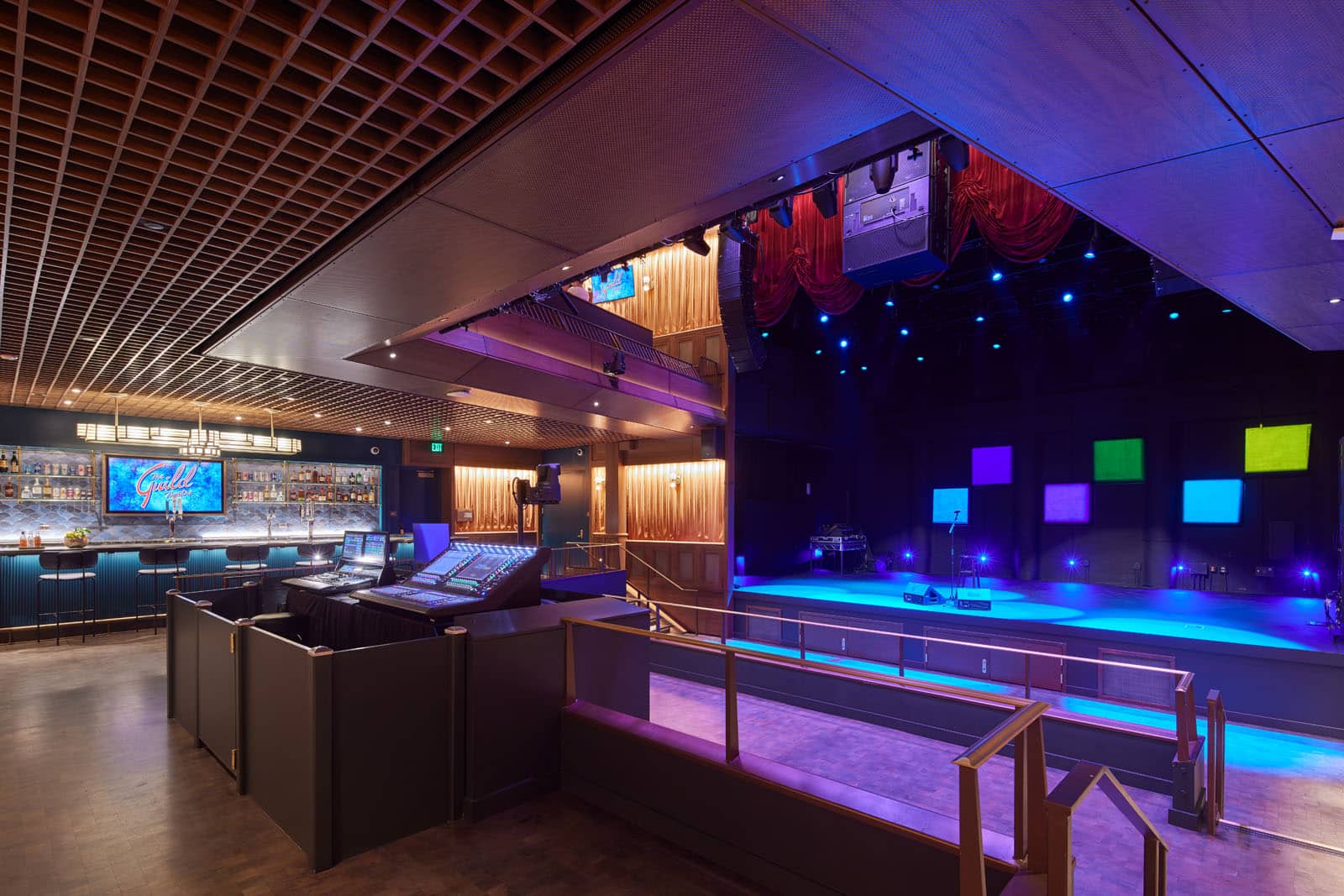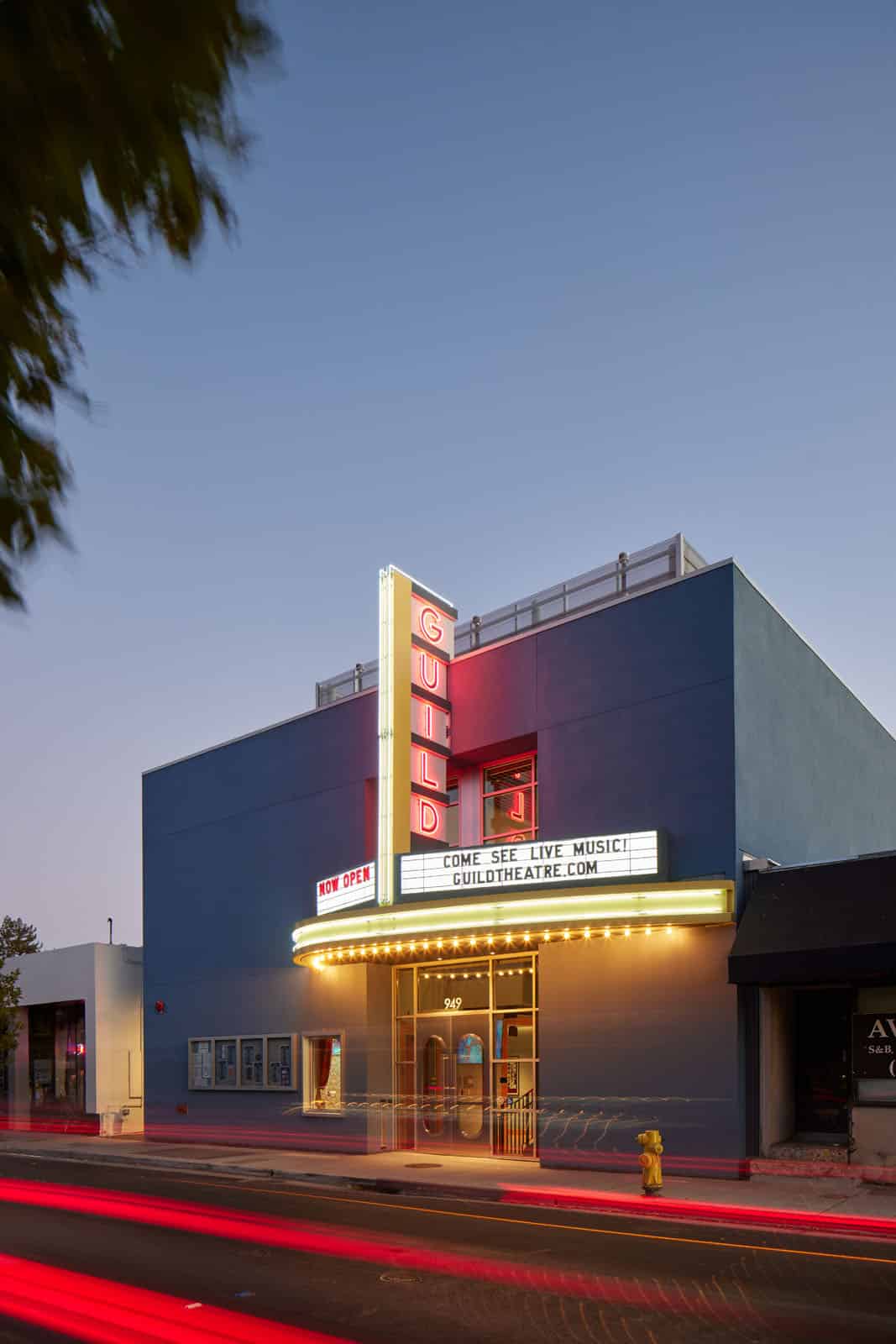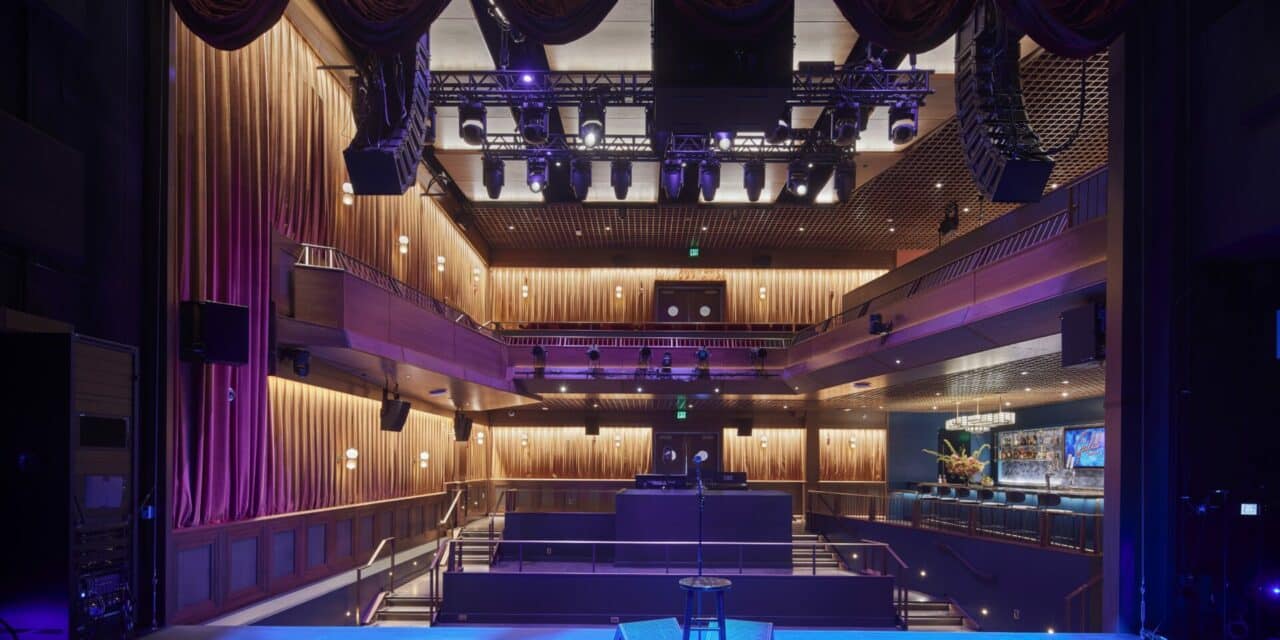GOLD MINE: The 500-capacity Guild Theatre emphasizes an intimate relationship between artist and audience. (Bruce Damonte)
It’s “The Guilded Age” in Menlo Park, California.
Returning glamor to an evening of good music, the Guild Theatre has ushered in a rebirth of the arts in the community that borders one of the richest zip codes in the U.S. – 94027. The Silicon Valley community had a median home price of $7.9 million in 2022.
The Guild Theatre, which opened in February 2022, is a thriving example of mission-based revitalization funded by the affluent community it serves with a nonprofit, Peninsula Arts Guild, at the center of the initiative to bring world-class, live performances to the area.
“This is one of those ‘Only in Silicon Valley’ stories,’” said Chris Wasney, principal of CAW Architects, the project designer. “There are other things like it around the country, but not many, especially in a suburban town; to revitalize the nightlife is extraordinary. That’s less of a design story and more of a mission story I find very inspiring.”
CAW Architects, based in the Bay Area, developed a 500-capacity performance space that emphasizes the intimate relationship between artist and audience. The goal was to create a topline venue for well-known acts who value performing in a smaller setting as well as regional performers, film premieres, speaker series and other live events.
The project was driven by a California commute.

GOLDEN YEARS: Built in the 192s0s, the Guild’s main floor includes a bar featuring a light fixture from its original days as a movie house. (Bruce Damonte)
“It’s certainly a first-world problem to drive 45 minutes to see a show in the city, but it’s kind of a pain on a Wednesday night when you have an early meeting the next day,” said Drew Dunlevie, president of the Peninsula Arts Guild board. “It’s a very old Silicon Valley success story, in that we saw a problem – that was our problem – and we tried to fix it and scratch our own itch.”
In 2017, Dunlevie along with Thomas Layton and Pete Briger formed the nonprofit board that eventually made the music mission a reality. Peninsula Arts Guild purchased the property for $3.2 million in 2019, renovated it and now operates the venue through the generosity of dozens of like-minded donors.
“There are many wealthy people out here and and a great many of them are incredibly generous and philanthropically oriented,” Dunlevie said.
The vision was to build an intimate venue that would attract stadium-level acts in a smaller setting and serve the community through arts and education programs.
The Guild replicates a traditional theater with a series of viewing terraces and stepped-down flooring, paired with a stage height of three feet, allowing performers to play to standing room crowds or seated. The stage, patterned after legendary Fillmore in San Francisco, is larger than typical venues of that size and artist amenities are designed to appeal to performers who routinely play larger venues and value comfort on the road.
“It’s thrilling for the audience and for the artists, it harkens back to their club days, and I think they love that,” Wasney said.

THE BUILD: The Guild Theatre’s historic marquee and neon sign. (Bruce Damonte)
Artists that have performed since in the venue include Nathaniel Rateliff and The Night Sweats, Social Distortion and a screening of Oliver Stone’s documentary “Nuclear.” In March, Jewel and The Chainsmokers will perform and in early April, Bobby Weir and the Wolf Brothers Trio have a five-day residency. The Guild team includes day-to-day talent buyer Molly Butera and general manager Tom Bailey, who was GM at the Capitol Theatre in Port Chester, New York, for 12 years before joining the Guild.
“There’s a way to get these large acts to come in and that’s to introduce them to the largess of this community,” Dunlevie explained, adding that several appearances are designed to benefit charities important to the artists. “There are many concentric rings of wealth levels here and the average guy has plenty of money and is willing to pay a decent amount to see Nathaniel Rateliff and The Night Sweats in a 500-capacity room. We can help them raise meaningful funds for the things they support.”
“They are getting these underplays that are generating a lot of buzz,” Wasney added.
Originally dating back to the 1920s, the former single-screen movie theater was reduced to two exterior walls, which were painstakingly supported while a full basement was excavated for support space for the project, which cost $35 million.
“Calling it a restoration might be a bit of a misnomer,” said Wasney, who recalled seeing “This is Spinal Tap” in the original theater in the mid ‘80s. “It’s a really tiny parcel, so much so that the excavation equipment didn’t fit on the site. So, it was a real logistical triumph for the contractor to build a ship in the bottle.”
The exterior of the fully remodeled theater underwent substantial new construction and was properly scaled for a zero setback that honored the restored historic blade sign and iconic neon marquee. Glazing was added to the facade to showcase the activity in both lower and upper lobbies on show nights.
Swinging entry doors, outfitted with custom portholes, lead into the lobby where the terrazzo flooring was designed with an inlaid reference to a vintage phonograph. The box office is outfitted in a custom California poppy wallpaper inspired by the venue’s original wall coverings.
Reviving some of the original grandeur, notable interior designer Ken Fulk restored the existing art deco lighting, including a chandelier of that period over the main bar. There are rock crystal fixtures throughout with a color scheme of California poppy orange and burgundy with leather, brass, walnut and glossy lacquered wall panels.
Interior heights were designed around the need for specific theater systems and rigging above the stage. The biggest design challenge was managing the acoustics. Design finishes were selected for maximum absorbency, so that virtually no surface reflects sound back to the source. A deep walnut palette, which aesthetically makes for a dark, warm interior, serves a second acoustical mission. Each solid panel of walnut has holes and perforations that allow sound to pass through.
“The thing with heavily amplified music is that every material has to be able to do two or three things,” Wasney said. “It has to be acoustically appropriate and either reflect or absorb sound appropriately, has to look beautiful and has to take a punch because these things get heavy use.”
Walnut “egg crate” ceiling systems and wood paneling perform similar double duty. Walnut flooring, cut to reveal the end grain, provides a durable material that is both attractive and virtually indestructible, according to Wasney.
A flexible guardrail system in the balcony section allows for varied heights depending on the needs of the show, whether it is a seated or standing room event. A velvet curtain frames the stage and was designed with maximum versatility to provide multiple options for a variety of performances. The Guild features two decorative bars including fluted blue granite downstairs and glowing pink rose quartz on the balcony level, where people congregate.
Dunlevie still drives to San Francisco for shows, but spends more time in Menlo Park recently seeing 10 shows in nine days. “Getting those big-time people in the room is cool,” he admits. “I always believed we could.”







